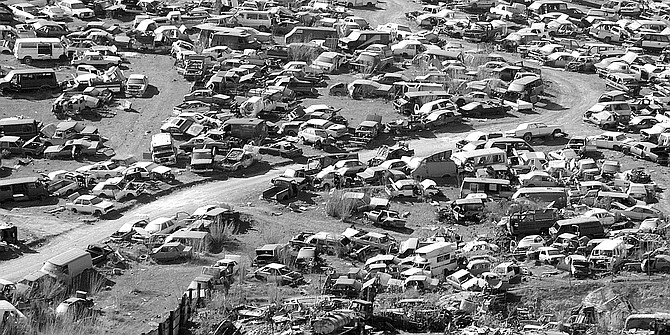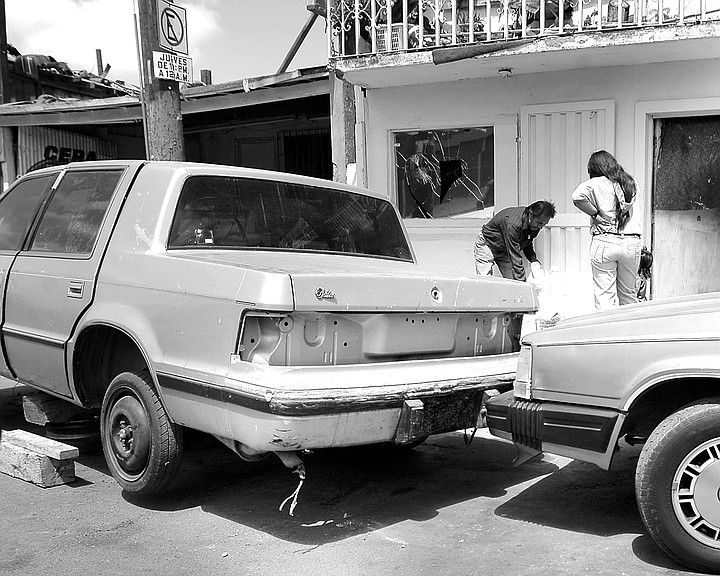 Facebook
Facebook
 X
X
 Instagram
Instagram
 TikTok
TikTok
 Youtube
Youtube

Though the municipal government unveils a new mass-transit proposal every few years, the fact remains: Tijuana is a city of cars. But it isn't a city of new cars. Only the wealthiest of tijuanenses drive new cars because financing for new cars is nearly nonexistent in Mexico, and most people don't have $20,000 plus in cash to lay out for a new car. But Mexicans in the border region have access to used cars from the United States. This is particularly true in Tijuana, which sits adjacent to the United States' seventh largest city and two hours from its second largest.

"It is relatively easy to get a car down here," says Rafael Sánchez, recaudador de rentas for the municipal government. "For one hundred or a couple hundred dollars, you can get a car."

Sánchez, a solidly built man with thinning hair and a brush mustache, leans forward on his polished walnut desk, which contrasts in its luxuriousness with the rough concrete walls of his office in Tijuana's zona rio government center. There's no equivalent for Sánchez's position in American municipal government. His office is in charge of collecting municipal taxes, fees, and fines. It's also in charge of setting up auctions for the thousands of cars that the city impounds and nobody ever claims.
The low price that cars can be purchased for in Tijuana contributes to the problem. "A car bought for $100 or $200 is probably illegal," Sánchez says, "meaning it has no Mexican plates or no registration. If the driver gets fined or in an accident, they just abandon the car and go, because they only paid $100 or $200 for the car, and it might not be worth it for them to spend that money to recuperate the car. Then, because the cars are usually not in their name, they have no problem with fines afterward. They just go out and buy another car for $200."
Sánchez adds that, even if the drivers wanted to reclaim the cars, they often can't because "They don't have the title so the yard won't give it back to them because, officially, they are not the owners."
Roughly 53,000 cars that the city of Tijuana, through its towing concessionaires, has impounded over the years sit in huge yards on the periphery of the city — near the Rodriguez dam southeast of the city and in the submunicipality of La Gloria south of the city. A smaller number rust away in one- and two-acre lots wedged into the middle of the city. Jalopies abandoned after wrecks and breakdowns make up a significant percentage of the 53,000. (Sánchez refuses to venture an estimate.) Recovered stolen vehicles make up part of that number. Illegally parked cars that get towed away make up another part. And cars involved in crime investigations are yet another part. "They can't touch them while the investigation is ongoing," Sánchez explains, "so they just stay there. There are a lot of those, too."
Another large percentage of the total consists of nicer cars owned by tijuanenses but displaying California plates with expired registration. "If someone is involved in some sort of an accident or an infraction with a fine," Sánchez explains, "and his car is still under the name of the original owner from the United States, if the driver cannot prove legal ownership, we will impound them and keep them until they can prove it. They have to at least show a receipt or some kind of bill of sale to get it back."
Such proof doesn't always exist in Tijuana, where most cars are sold in private transactions. And even when it does exist, tijuanenses assume that half of the car they saw towed away will be stripped and sold on Tijuana's enormous used-car-parts market before they could recover it. Sánchez acknowledges that fact and says the municipal government is working to change that. "Since October," he says, "we have had new towing and storage concessionaires who operate under new guidelines, which give us better control. For instance, now, before a car goes into the yard, somebody from the municipal government goes out there. They take photos inside and outside of the car and also take an inventory. This is in order to avoid things being taken, such as tires or stereos. Then, there is a Web page that you can actually access and see if your car was stolen or if your car was impounded. You can check either based on the license plate or the serial number. You can also look for it based on the model. You can see a picture of the car on the site."
Sánchez adds, "Because this new system has only started in October, the list is not that big yet. The majority of the cars among the 53,000 cars we have were towed by the old concessionaires, and they are in their yards."
Asked if the cars are a financial burden to the municipal government, Sánchez shakes his head no and explains that the new system should benefit both the city and the towing concessionaire. "The new arrangement is...let's say that your car was towed. The towing company gives you a slip that lists a charge for towing, a charge for storage, and whatever fine the infraction carries. Then the city collects everything, keeps all of the fine, of course, and also 16 to 18 percent of the towing and storage fees. The rest is given to the concessionaires."
But because many tijuanenses abandon their cars rather than pay traffic fines and towing fees, the only way for the towing company to make any money off those cars is to sell them for scrap at auction. Arranging such auctions is one of Sánchez's functions. "The process to get them out as junk," he explains, "takes about three months on average because there is a whole legal procedure that we have to follow. We need to buy advertisements and publicize in official newspapers and local newspapers the list of all the cars that we have in the yards to see if somebody doesn't find their car there. And that is why the process is slow. After we publicize the list, we publish an open request for bids. We say, for example, 'We have 500 junk cars; who is interested in buying them?' Normally, the yard owners are the ones that keep them because, the majority of the time, nobody buys them."
Sánchez explains, "The concessionaire wants to recuperate the money he lost on towing and storage. So when you see the advertisement, and you go to buy the 500 junk cars, the concessionaire tells you, 'Okay, you pay the junk price [to the municipal government], but then you still owe me for the towing and the storage.' Then you say, 'Well, I don't want it.' And then, in the end, the concessionaire keeps them and either sells off the parts or sells the whole car for scrap steel. So towing these cars in the first place is kind of an investment for the concessionaires."


Though the municipal government unveils a new mass-transit proposal every few years, the fact remains: Tijuana is a city of cars. But it isn't a city of new cars. Only the wealthiest of tijuanenses drive new cars because financing for new cars is nearly nonexistent in Mexico, and most people don't have $20,000 plus in cash to lay out for a new car. But Mexicans in the border region have access to used cars from the United States. This is particularly true in Tijuana, which sits adjacent to the United States' seventh largest city and two hours from its second largest.

"It is relatively easy to get a car down here," says Rafael Sánchez, recaudador de rentas for the municipal government. "For one hundred or a couple hundred dollars, you can get a car."

Sánchez, a solidly built man with thinning hair and a brush mustache, leans forward on his polished walnut desk, which contrasts in its luxuriousness with the rough concrete walls of his office in Tijuana's zona rio government center. There's no equivalent for Sánchez's position in American municipal government. His office is in charge of collecting municipal taxes, fees, and fines. It's also in charge of setting up auctions for the thousands of cars that the city impounds and nobody ever claims.
The low price that cars can be purchased for in Tijuana contributes to the problem. "A car bought for $100 or $200 is probably illegal," Sánchez says, "meaning it has no Mexican plates or no registration. If the driver gets fined or in an accident, they just abandon the car and go, because they only paid $100 or $200 for the car, and it might not be worth it for them to spend that money to recuperate the car. Then, because the cars are usually not in their name, they have no problem with fines afterward. They just go out and buy another car for $200."
Sánchez adds that, even if the drivers wanted to reclaim the cars, they often can't because "They don't have the title so the yard won't give it back to them because, officially, they are not the owners."
Roughly 53,000 cars that the city of Tijuana, through its towing concessionaires, has impounded over the years sit in huge yards on the periphery of the city — near the Rodriguez dam southeast of the city and in the submunicipality of La Gloria south of the city. A smaller number rust away in one- and two-acre lots wedged into the middle of the city. Jalopies abandoned after wrecks and breakdowns make up a significant percentage of the 53,000. (Sánchez refuses to venture an estimate.) Recovered stolen vehicles make up part of that number. Illegally parked cars that get towed away make up another part. And cars involved in crime investigations are yet another part. "They can't touch them while the investigation is ongoing," Sánchez explains, "so they just stay there. There are a lot of those, too."
Another large percentage of the total consists of nicer cars owned by tijuanenses but displaying California plates with expired registration. "If someone is involved in some sort of an accident or an infraction with a fine," Sánchez explains, "and his car is still under the name of the original owner from the United States, if the driver cannot prove legal ownership, we will impound them and keep them until they can prove it. They have to at least show a receipt or some kind of bill of sale to get it back."
Such proof doesn't always exist in Tijuana, where most cars are sold in private transactions. And even when it does exist, tijuanenses assume that half of the car they saw towed away will be stripped and sold on Tijuana's enormous used-car-parts market before they could recover it. Sánchez acknowledges that fact and says the municipal government is working to change that. "Since October," he says, "we have had new towing and storage concessionaires who operate under new guidelines, which give us better control. For instance, now, before a car goes into the yard, somebody from the municipal government goes out there. They take photos inside and outside of the car and also take an inventory. This is in order to avoid things being taken, such as tires or stereos. Then, there is a Web page that you can actually access and see if your car was stolen or if your car was impounded. You can check either based on the license plate or the serial number. You can also look for it based on the model. You can see a picture of the car on the site."
Sánchez adds, "Because this new system has only started in October, the list is not that big yet. The majority of the cars among the 53,000 cars we have were towed by the old concessionaires, and they are in their yards."
Asked if the cars are a financial burden to the municipal government, Sánchez shakes his head no and explains that the new system should benefit both the city and the towing concessionaire. "The new arrangement is...let's say that your car was towed. The towing company gives you a slip that lists a charge for towing, a charge for storage, and whatever fine the infraction carries. Then the city collects everything, keeps all of the fine, of course, and also 16 to 18 percent of the towing and storage fees. The rest is given to the concessionaires."
But because many tijuanenses abandon their cars rather than pay traffic fines and towing fees, the only way for the towing company to make any money off those cars is to sell them for scrap at auction. Arranging such auctions is one of Sánchez's functions. "The process to get them out as junk," he explains, "takes about three months on average because there is a whole legal procedure that we have to follow. We need to buy advertisements and publicize in official newspapers and local newspapers the list of all the cars that we have in the yards to see if somebody doesn't find their car there. And that is why the process is slow. After we publicize the list, we publish an open request for bids. We say, for example, 'We have 500 junk cars; who is interested in buying them?' Normally, the yard owners are the ones that keep them because, the majority of the time, nobody buys them."
Sánchez explains, "The concessionaire wants to recuperate the money he lost on towing and storage. So when you see the advertisement, and you go to buy the 500 junk cars, the concessionaire tells you, 'Okay, you pay the junk price [to the municipal government], but then you still owe me for the towing and the storage.' Then you say, 'Well, I don't want it.' And then, in the end, the concessionaire keeps them and either sells off the parts or sells the whole car for scrap steel. So towing these cars in the first place is kind of an investment for the concessionaires."
Comments